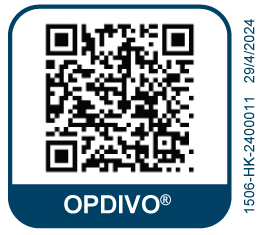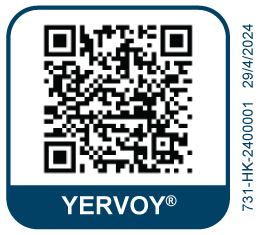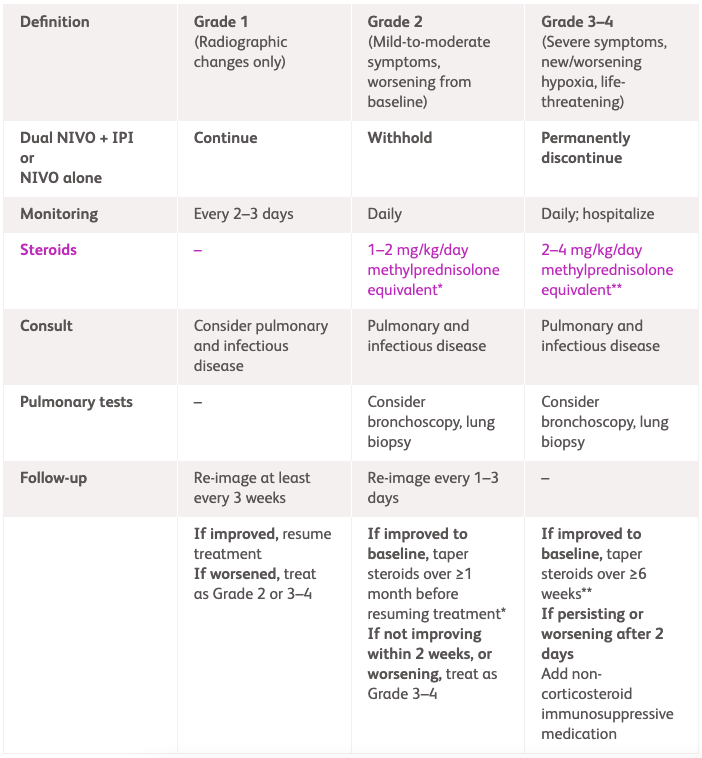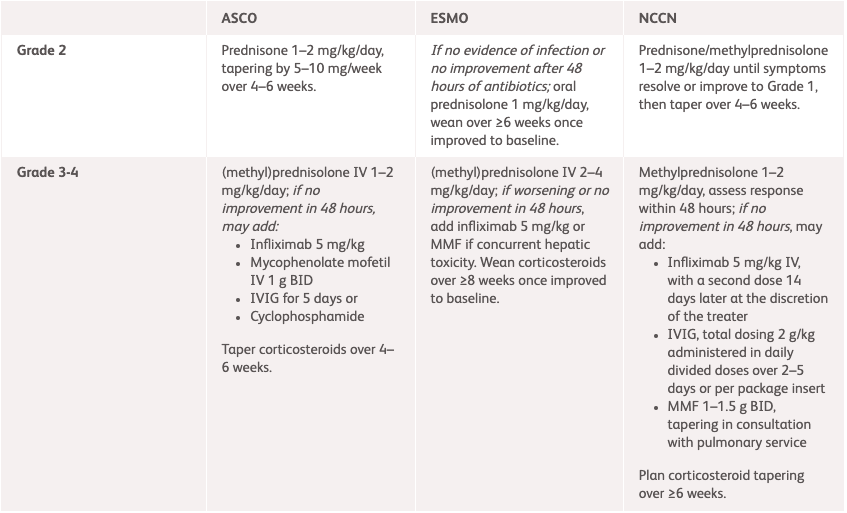Management guidelines for pulmonary irAEs1-3
Common pulmonary irAE symptoms
BMS-recommended management guidelines for pulmonary irAEs3
For suspected irAEs, first exclude other causes; consult with pulmonology and conduct imaging for respiratory status changes
| Grade 1 | Grade 2 | Grade 3–4 | |
|---|---|---|---|
| Definition | Radiographic changes only | Mild-to-moderate symptoms, worsening from baseline | Severe symptoms, new/worsening hypoxia, life-threatening |
| Dual NIVO + IPI
or NIVO alone1 |
Consider withholding | Withhold | Permanently discontinue |
| Monitoring | Every 2–3 days | Daily | Daily; hospitalise |
| Medication | – | 1–2 mg/kg/day methylprednisolone equivalent* | 2–4 mg/kg/day methylprednisolone equivalent** |
| Consult | Consider pulmonary and infectious disease | Pulmonary and infectious disease | Pulmonary and infectious disease |
| Pulmonary tests | – | Consider bronchoscopy, lung biopsy | Consider bronchoscopy, lung biopsy |
| Follow-up | Re-image at least every 3 weeks | Re-image every 1–3 days | – |
| If improved, resume treatment
If worsened, treat as Grade 2 or 3–4 |
If improved to baseline, taper steroids over ≥1 month before resuming treatment*
If not improving within 2 weeks, or worsening, treat as Grade 3–4 |
If improved to baseline, taper steroids over ≥6 weeks**
If persisting or worsening after 2 days Add non-corticosteroid immunosuppressive medication |
*Consider prophylactic antibiotics for opportunistic infections; **Add prophylactic antibiotics
IPI, ipilimumab; irAE, immune-related adverse event; NIVO, nivolumab
International guideline (ASCO, ESMO and NCCN) recommendations for pulmonary irAEs4–6^
^ For detailed guidelines, please refer to original publication
| Grade 1 | Grade 2 | Grade 3–4 | |
|---|---|---|---|
| Immunotherapy | (Consider) hold4,6/delay5 | Hold4–6 | Permanently discontinue4–6 |
| Escalation | If no improvement, treat as Grade 26
If worsening, treat as Grade 2 or Grade 3–45 |
If no improvement after 485–724,6 hours of recommended corticosteroids, treat as Grade 3 | – |
| Imaging/investigations | As per monitoring section | As per monitoring section
Consider bronchoscopy ± BAL4,5 transbronchial biopsy6 Chest CT with contrast5 |
Bronchoscopy ± BAL
High-resolution CT, respiratory review5 Consider transbronchial lung biopsy4,6 Infectious workup,4 consider cardiac evaluation4 |
| Medication | – | Prednisone,4,6 (methyl)prednisolone4,5* | IV (methyl)prednisolone with4–6:
|
| Antibiotics/prophylaxis | – | Consider empiric antibiotics4,6
Start if infection suspected5 Consider pneumocystis prophylaxis5 |
(Consider)4 empiric antibiotics5 |
| Consultation | – | Consider pulmonary4 and infectious disease6 | Pulmonary and infectious disease4,6 |
| Admission | – | – | Admit/hospitalise4–6 |
*Consult steroid and immunosuppressive dosing information below for recommendations
BAL, bronchoalveolar lavage; CT, computed tomography; IV, intravenous; IVIG, intravenous immunoglobulin
Diagnostic assessment may include chest x-ray, CT, pulse oximetry, blood panels (FBC/UEC/LFTs/TFTs/Ca/ESR/CRP),5 nasal swabs, sputum and urine testing.4–6 ESMO recommends considering a sputum sample and screening for infectious causes even at the Grade 1 level5; ASCO and the NCCN recommend these investigations only at Grade ≥2.4,6
|
ASCO, ESMO, NCCN |
|||
|---|---|---|---|
| Grade 1 | Grade 2 | Grade 3 | Grade 4 |
| Asymptomatic, confined to one lobe or <25% of lung parenchyma; clinical or diagnostic observations only; ground-glass change, non-specific interstitial pneumonia. | Symptomatic, involving more than one lobe of the lung or 25–50% of the lung parenchyma; medical intervention indicated; limiting instrumental ADL.6 The presence of new or worsening symptoms.4,5 Dyspnoea, shortness of breath, cough, chest pain, increased oxygen requirement.5 Consider cardiac etiologies.4 | Severe (new) symptoms; hospitalisation required; involves all lung lobes or >50% of lung parenchyma, limiting self-care ADL. New/worsening hypoxia, life-threatening, difficulty in breathing, acute respiratory distress. Oxygen indicated. | As Grade 3, with life-threatening respiratory compromise. Urgent intervention (intubation) indicated. |
ADL, activities of daily living; ASCO, American Society of Clinical Oncology; Ca, calcium; CRP, C-reactive protein; CT, computed tomography; ESMO, European Society for Medical Oncology; ESR, erythrocyte sedimentation rate; FBC, full blood count; LFT, liver function test; NCCN, National Comprehensive Cancer Network; TFT, thyroid function test; UEC, urea, electrolytes, creatinine
| ASCO6 | ESMO5 | NCCN4 | |
|---|---|---|---|
| Grade 1 | Reassess history, conduct a physical examination and pulse oximetry on the schedule indicated below, plus any supplementary investigations as described. | ||
| Weekly.
May offer chest x-ray. May offer repeat CT in 3–4 weeks as well as repeat spirometry/DLCO if done at baseline. |
Every 2–3 days.
Baseline indications:
Consider sputum and screening for viral, opportunistic or specific bacterials infections (Mycoplasma, Legionella) depending on the clinical context. |
Within 1–2 weeks.
Consider a chest CT with contrast, and repeat CT in 4–6 weeks or if clinically indicated by patient developing symptoms. |
|
| Grade 2 | At least once per week. | Daily.
Outpatient monitoring: Chest CT with contrast, consider infection work (sputum, blood and urine culture), bronchoscopy with BAL to rule out infection and tumour infiltration. Baseline indications: As grade 1, with the addition of repeating chest x-ray weekly, baseline blood tests and LFTs including TLCO. |
Every 3–7 days.
Consider chest CT with contrast and repeat chest CT in 3–4 weeks. Consider infectious workup (nasal swab, sputum culture, blood culture, urine antigen test). |
| Grade 3–4 | At these grades, patients should be admitted for inpatient care/hospitalised and receiving active medical intervention. | ||
ASCO, American Society of Clinical Oncology; BAL, bronchoalveolar lavage; CT, computed tomography; DLCO, diffusing capacity of lung for carbon monoxide; ESMO, European Society for Medical Oncology; LFT, liver function test; NCCN, National Comprehensive Cancer Network; TCLO, transfer factor for carbon monoxide
| ASCO6 | ESMO5 | NCCN4 | |
|---|---|---|---|
| Grade 2 | Prednisone 1–2 mg/kg/day, tapering over 4–6 weeks. | If no evidence of infection or no improvement after 48 hours of antibiotics;
oral prednisolone 1 mg/kg/day, wean over 4–6 weeks once improved to baseline. |
Prednisone/methylprednisolone 1–2 mg/kg/day until symptoms improve to Grade 1, then taper over 4–6 weeks. |
| Grade 3–4 | (methyl)prednisolone IV 1–2 mg/kg/day; if no improvement in 48 hours, may add:
Taper corticosteroids over 4–6 weeks. |
(methyl)prednisolone IV 1–2 mg/kg/day; if no improvement in 48 hours, may add:
Consider MMF or cyclophosphamide. |
Methylprednisolone 1–2 mg/kg/day, assess response within 48 hours; if no improvement in 48 hours, may add:
Plan corticosteroid tapering over ≥6 weeks. |
ASCO, American Society of Clinical Oncology; BID, twice daily; ESMO, European Society for Medical Oncology; IV, intravenous; IVIG, intravenous immunoglobulin; MMF, mycophenolate mofetil; NCCN, National Comprehensive Cancer Network; PO, orally
ASCO, American Society of Clinical Oncology; ESMO, European Society for Medical Oncology; irAE, immune-related adverse event; NCCN, National Comprehensive Cancer Network
References:
- OPDIVO® (nivolumab) Product Information, BMS Hong Kong.
- YERVOY® (ipilimumab) Product Information, BMS Hong Kong.
- Bristol-Myers Squibb. Immune-Related Adverse Reaction (irAR) Management Guide. 1506AU2002148-01. April 2020.
- National Comprehensive Cancer Network. NCCN Clinical Practice Guidelines in Oncology. Management of immunotherapy-Related Toxicities. Version 1.2022. Available at: https://www.nccn.org/professionals/physician_gls/pdf/immunotherapy.pdf. Accessed February 2023.
- Haanen J, et al. Ann Oncol 2022;33:1217–1238. Available at: https://www.annalsofoncology.org/article/S0923-7534(22)04187-4/fulltext. Accessed March 2023.
- Schneider BJ, et al. J Clin Oncol 2021;39:4073–4126. Available at: https://ascopubs.org/doi/full/10.1200/JCO.21.01440. Accessed March 2023.






